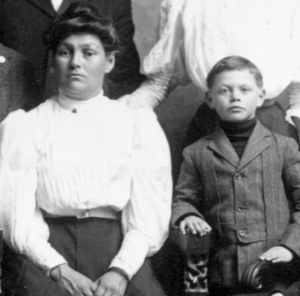Click on the “play” button to hear the diary episode read aloud, and click on the green tab 1 to learn more about a word or phrase.
Find Du Vernet on a map.
Wednesday, July 20:
Today was a most beautiful day, after the rain. The atmosphere was very clear and the rippling water sparkled in the sunlight. I enjoyed my morning dip in the river more this morning than yesterday because I was not devoured by mosquitoes the moment I came out of the water.
As Mrs. Johnston 2 was so anxious to have Sammie’s picture, at about 10 o’clock I had him sitting in his chair below the house so that part of the river might form a background. But on the first try I exposed on a plate 3 that I had already used and so have no doubt spoilt the group picture taken in front of the Church 4 Monday morning. So I tried another, and yet another. I feel the last one was a failure as I did not hear the return click of the shutter. Never mind, it pleased them.
Mr. Johnston 5 and the student doing duty at Boucherville 6 , Mr. L. Swalwell 7 , returned in time for dinner. I had a long talk with the young man, who seems to be an earnest worker. After dinner I felt that as the air was so clear and the beautiful fleecy clouds were rolling across the sky I must take the last two pictures that I had available. So at about 2:30 p.m. I took one of the Church from the middle of the garden, with Mr. Johnston and Mr. Swalwell standing near the Church.
After that Mr. Swalwell left for Boucherville, and I went with Mr. Johnston to take a picture of the three graves 8 of “grandfather’s” grandchildren. On our way, we saw old “grandmother” 9 who is so opposed to Christianity sitting outside her house. When we asked her if she would come and sit by the graves on the chair there she refused, remarking in reply to our promise to send her a copy that “If I thought I could get something to eat out of that picture every time I looked at it I might come.” I had Mr. Johnston sit in the chair instead. The women all disappeared into the houses 10 .
After this I tried fishing again. The water looked most beautiful, glistening in the rays of the afternoon sun. I caught one pickerel. While I was fishing, two Indians paddled upstream in their birch bark canoe, and came to rest under the shelter of the point where I was standing, so close that I could touch the Canoe with my hand.
We said “Bon Jour” and then the Indian talked and I shook my head. When I pointed to the rapid water and asked him if there were fish there, he said “Yes.” After resting, they shot out into the stream: their canoe was caught on the current and carried rapidly downward but they paddled hard and made the shelter of the other shore. Seeing this, I thought that spending time in such resting places in quiet water, before dashing out into the swiftly flowing stream to struggle against it, is a picture of seasons of prayer 11 on Sundays.
Later that day, I heard that “Charlie 12 ” was going through the long tent 13 .
As the weather was cooler it was pleasant to be out in the evening with a smudge 14 near by.
The setting sun over the mirror-like water, the wooded shores before it, was a picture not soon to be forgotten.

